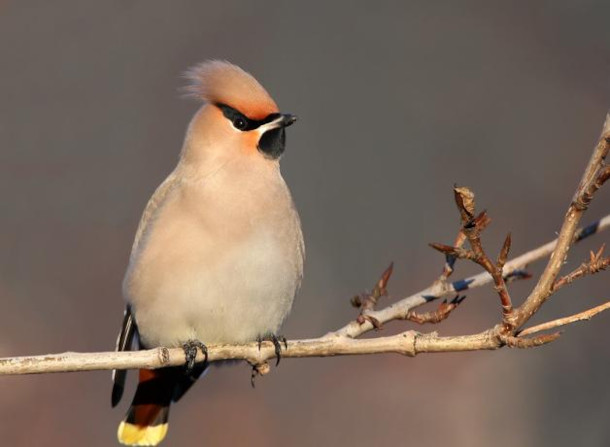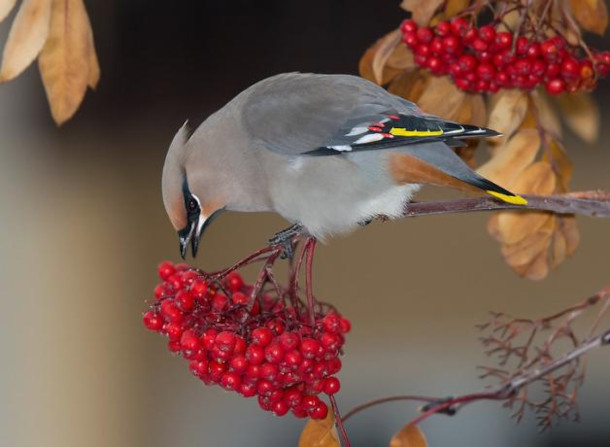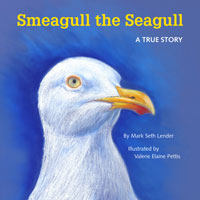BirdNote®: Waxwing Nightlight
Air Date: Week of January 17, 2025

The bright coloration of bohemian waxwings led people to believe that the birds could glow in the dark. (Photo: © Sindri Skúlason, courtesy of BirdNote®)
Waxwings were once believed to glow in the dark, and Pliny the Elder reported that their feathers were said to “shine like flames” in the dark forests of central Europe. That is, until one sixteenth-century Italian birder decided to take a closer look, says BirdNote®’s Mary McCann.
Transcript
DOERING: Brilliant red winterberries shine amid the muted tones of this season, and throughout the winter they feed fruit-loving birds like waxwings. But as BirdNote®’s Mary McCann tells us; the birds themselves were once believed to shine even brighter.
BirdNote®
Waxwing Nightlight
Written by Rick Wright
MCCANN: For the better part of two thousand years, the waxwing was credited with an amazing power.
[Richard Wagner, Siegfried-Idylle]
[Bohemian Waxwing calls and “song,” ML 170762, 04:26 and following]
It was believed in all earnestness that these gentle, crested fruit-eaters glowed in the dark.
Pliny reported that their feathers were said to “shine like flames” in the dark forests of central Europe. The Latin scholar Solinus went further: Not only did waxwings throw off a warm glow, he said, the Germans used captive birds to light their way when they were obliged to travel by night.
[Richard Wagner, Siegfried-Idylle]
But at the end of the sixteenth century, the great Italian bird man Ulysses Aldrovandi was skeptical. In his twelve-volume encyclopedia of ornithology, Aldrovandi admits that the waxy red tips on the bird’s wing feathers are beautiful, but he dismisses the notion that they give off any kind of light.
How could he be so sure?
“For nearly three months,” he writes, “I kept a waxwing alive in my house and observed it through the night.” He goes on to note the bird stubbornly failed to emit flames or light of any kind.
Today, no one thinks that waxwings glow in the dark. But that doesn’t stop these winter nomads from brightening the birdwatcher’s day.
[Richard Wagner, Siegfried-Idylle]
[Bohemian waxwing calls and “song,” ML 170762, 04:26 and following]
I’m Mary McCann.
###

A bohemian waxwing picks at a red berry. (Photo: © Keith Williams CC, courtesy of BirdNote®)
Bird sounds provided by The Macaulay Library of Natural Sounds at the Cornell Lab of Ornithology, Ithaca, New York. Bohemian Waxwing, ML 170762, recorded by David A. McCartt.
Richard Wagner, Siegfried-Idylle. youtube.com/watch?v=891JUSQplzU Performed by Sergiu Celibidache and the Münchner Philharmoniker.
BirdNote’s theme music was composed and played by Nancy Rumbel and John Kessler.
Senior Producer: Mark Bramhill
Producer: Sam Johnson
Content Director: Jonese Franklin
© 2015 Tune In to Nature.org December 2015/2018/2020 November 2024 Narrator: Mary McCann
ID# BOWA-03-2015-12-30 BOWA-03
https://www.birdnote.org/podcasts/birdnote-daily/waxwing-nightlight
DOERING: For pictures, fly over to the Living on Earth website at loe dot org.
Links
Living on Earth wants to hear from you!
Living on Earth
62 Calef Highway, Suite 212
Lee, NH 03861
Telephone: 617-287-4121
E-mail: comments@loe.org
Newsletter [Click here]
Donate to Living on Earth!
Living on Earth is an independent media program and relies entirely on contributions from listeners and institutions supporting public service. Please donate now to preserve an independent environmental voice.
NewsletterLiving on Earth offers a weekly delivery of the show's rundown to your mailbox. Sign up for our newsletter today!
 Sailors For The Sea: Be the change you want to sea.
Sailors For The Sea: Be the change you want to sea.
 The Grantham Foundation for the Protection of the Environment: Committed to protecting and improving the health of the global environment.
The Grantham Foundation for the Protection of the Environment: Committed to protecting and improving the health of the global environment.
 Contribute to Living on Earth and receive, as our gift to you, an archival print of one of Mark Seth Lender's extraordinary wildlife photographs. Follow the link to see Mark's current collection of photographs.
Contribute to Living on Earth and receive, as our gift to you, an archival print of one of Mark Seth Lender's extraordinary wildlife photographs. Follow the link to see Mark's current collection of photographs.
 Buy a signed copy of Mark Seth Lender's book Smeagull the Seagull & support Living on Earth
Buy a signed copy of Mark Seth Lender's book Smeagull the Seagull & support Living on Earth

